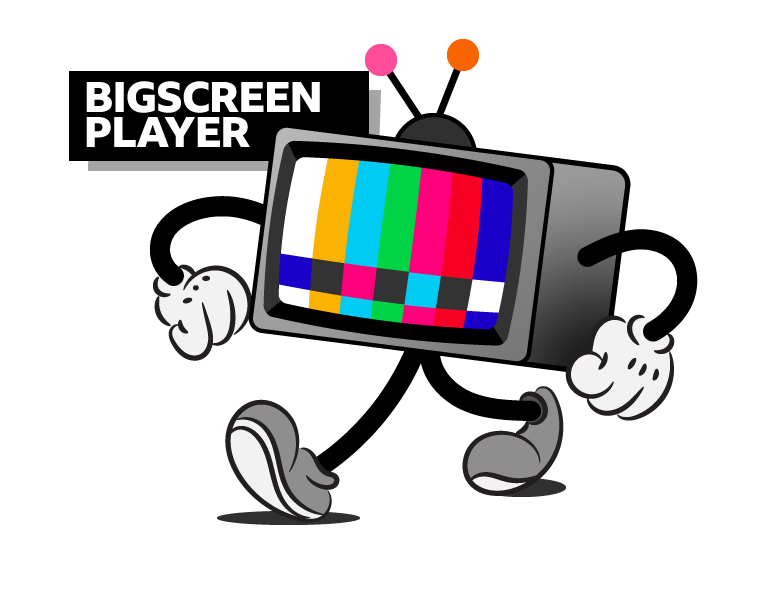Subtitles
BigscreenPlayer aims to provide a consistent experience across all devices regardless of the underlying playback strategy and native functionality. The player can render subtitles (aka captions) with on-demand and live content. You can also customise the appearance of your subtitles using this library.
To achieve that consistent experience BigscreenPlayer cannot render subtitles as you would using f.ex. Dash.js. Some devices do not support text tracks natively, others do not present cues accurately (more detail here). For this reason you SHOULD NOT specify subtitles in your manifest. Instead you SHOULD provide subtitles separately to make use of the capabilities BigscreenPlayer provides.
Usage
You provide subtitles to BigscreenPlayer by setting media.captions in the .init() data:
// 1️⃣ Add an array of caption blocks to your playback data.
playbackData.media.captions = [
/* caption blocks... */
]
// 2️⃣ Pass playback data that contains captions to the player.
player.init(document.querySelector("video"), playbackData /* other opts */)
media.captionsMUST be an array containing at least one object.- Each object in the captions array MUST have a property
url. - Each
urlSHOULD be a valid hyperlink to a subtitles resource.
Any subtitles resource you provide to BigscreenPlayer MUST be encoded with MIME type application/ttml+xml or application/ttaf+xml. You SHOULD NOT provide your subtitles in the manifest.
There are different requirements for subtitles delivered as a whole and subtitles delivered as segments:
As A Whole
Subtitles are delivered "as a whole" when the captions' url refers to a single file that contains all subtitles for the programme. For example:
// Each resource specifies subtitles for the whole media experience.
const captions = [
{ url: "https://some.cdn/subtitles.xml" },
{ url: "https://other.cdn/subtitles.xml" },
/* ... */
]
Subtitles delivered as a whole do not require any additional metadata in the manifest to work.
As Segments
Subtitles are delivered "as segments" when the captions' url is an URL template. An URL is considered a segment template when it contains a $...$ block. For example:
// Each segment specifies subtitles for a segment of the media experience.
const captions = [
{
url: "https://some.cdn/subtitles/$segment$.m4s",
segmentLength: 3.84,
cdn: "default",
},
{
url: "https://other.cdn/subtitles/$segment$.m4s",
segmentLength: 3.84,
cdn: "default",
},
/* ... */
]
The segment number is calculated from the presentation timeline. You MUST ensure your subtitle segments are enumerated to match your media segments and you account for offsets such as:
- The availability window (sliding, growing window)
- The presentation time offset (static window)
The subtitles segment length MUST match the media's segment length.
Styling
You can style the subtitles by setting media.subtitleCustomisation in the .init() data. media.subtitleCustomisation should be a key-value object containing valid TTML or HTML styles. If you use the legacy subtitles renderer TTML styles may not be supported.
Styling: Example
// 1️⃣ Create an object mapping out styles for your subtitles.
playbackData.media.subtitleCustomisation = { lineHeight: 1.5, size: 1 }
// 2️⃣ Pass playback data that contains subtitle customisation (and captions) to the player.
player.init(document.querySelector("video"), playbackData /* other opts */)
Low Latency Streams
When using Dash.js with a low-latency MPD segments are delivered using Chunked Transfer Encoding (CTE) - the default side chain doesn't allow for delivery in this case.
Whilst it is possible to collect chunks as they are delivered, wait until a full segment worth of subtitles have been delivered and pass these to the render function this breaks the low-latency workflow.
An override has been added to allow subtitles to be rendered directly by Dash.js instead of the current side-chain.
Subtitles can be enabled and disabled in the usual way using the setSubtitlesEnabled() function. However, they are signalled and delivered by the chosen MPD.
Using Dash.js subtitles can be enabled using window.bigscreenPlayer.overrides.embeddedSubtitles = true.
Design
Why not include subtitles in the manifest?
It is not recommended to include subtitles in the manifest(s) because the experience will not be consistent across devices. Timing models across devices are inconsistent. For example, there are devices where you cannot rely on the DOM media element to access the correct current time or seekable range (see Playable/Restartable/Seekable devices). Subtitles will be presented inaccurately when the current time is incorrect.
BigscreenPlayer mitigates inaccurate text tracks on devices using custom logic to present subtitles. Subtitles are in other words "side-cared". So you MUST provide subtitles in the captions block (if any), and SHOULD NOT include your in the manifest.
Architecture
BigscreenPlayer's subtitles presentation interface is implemented by:
- IMSC Subtitles (default)
- Legacy Subtitles
If you suspect a device is struggling to display subtitles for performance reasons, you can try to use the legacy subtitles renderer instead by setting: window.bigscreenPlayer.overrides.legacySubtitles = true.
Live/segmented subtitles are not supported by the legacy subtitles renderer.
